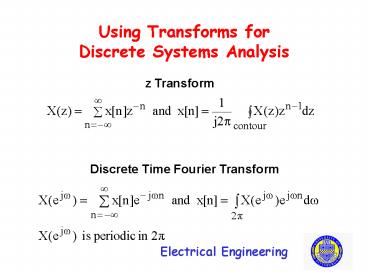Using Transforms for Discrete Systems Analysis - PowerPoint PPT Presentation
1 / 12
Title:
Using Transforms for Discrete Systems Analysis
Description:
Electrical Engineering. z Transform. Using Transforms for. Discrete Systems Analysis ... 0 to N-1 is. Electrical Engineering. Subtle problems in calculating ... – PowerPoint PPT presentation
Number of Views:43
Avg rating:3.0/5.0
Title: Using Transforms for Discrete Systems Analysis
1
Using Transforms forDiscrete Systems Analysis
z Transform
Discrete Time Fourier Transform
2
The 3-point moving average filter
3
Comparing frequency ranges
discrete frequency range
3p
-3p
p
-p
0
2p
4
Sampled Frequency Response
Sampling DTFT at 4 points
X
X
X
X
5
Sampled Frequency Response
Sampling DTFT at 8 points
X
X
X
X
X
X
X
X
6
Sampled Frequency Response
SamplingDTFT at 16 points
X
X
X
X
X
X
X
X
X
X
X
X
X
X
X
X
7
Discrete Fourier Transformsamples the
discrete-time Fourier transform
Direct Transform
z-plane
Imag z
X
X
X
Real z
X
X
Inverse Transform
X
X
X
Illustrates N 8
8
N-point transforms of discrete signals
Discrete Fourier TransformTo analyze a finite
duration signalBased on z-transform
Discrete Fourier SeriesTo analyze a periodic
signalDerived from series representation
Note that both transforms are periodic in N. Some
authors define the DFS as Nak and the synthesis
equation as xn/N. Equations are then the same
as for the DFT.
9
Fourier series of discrete sine
Script to compute the DFS. N 8
Set number of samples fc 20
Set signal frequency
to 20 Hz. fs fcN
Set sampling rate to 8x signal frequency M
0.2 for i 0N-1 Generate
discrete time series xd(i1)
Msin(2pi20i(1/fs)) end for k 0N-1
Loop to find discrete Fourier
series sum 0 for n 0N-1 sum
sum xd(n1)exp(-jkn2pi/N) end
a(k1) sum/N end or use MATLABs fft
command fxd fft(xd)/N
10
Sampling a continuous signal
x(t) 0.2 sin(2? 20t)
Sampling frequency fs 160 Hz Ts 1/160
xn x(t)tnTs 0.2 sin (2p 20n/160)
0.2 sin (n 2p / 8) Period N 8
and Discrete frequency 2 p/N p/4
rad Discrete frequency as a fraction of the
sampling rate is 2 p(20/160) p/4 Sampling
frequency corresponds to a discrete frequency of
2 p rad.
11
Frequency axes for the DFT
Time axis for plots t (01length(signal)-1)/fs
)
16 points sampled at fs 800 Hz gives 20
millisec of data
Range of DFT discrete frequencies for points 0 to
N-1 is
MATLAB
n 16 last point corresponds to ?
2?-?? which corresponds to 800 Hz-?f 750 Hz
1
1
Frequency axis for plots f (01length(DFT)-1)
fs/(length(DFT))
12
Subtle problems in calculating Fourier series































